
In naval terminology, a destroyer is a fast, maneuverable, long-endurance warship intended to escort larger vessels in a fleet, convoy, or carrier battle group and defend them against a wide range of general threats. They were originally conceived in 1885 by Fernando Villaamil for the Spanish Navy as a defense against torpedo boats, and by the time of the Russo-Japanese War in 1904, these "torpedo boat destroyers" (TBDs) were "large, swift, and powerfully armed torpedo boats designed to destroy other torpedo boats". Although the term "destroyer" had been used interchangeably with "TBD" and "torpedo boat destroyer" by navies since 1892, the term "torpedo boat destroyer" had been generally shortened to simply "destroyer" by nearly all navies by the First World War.

The Swedish Navy is the naval branch of the Swedish Armed Forces. It is composed of surface and submarine naval units – the Fleet – as well as marine units, the Amphibious Corps.

HSwMS Magne (30) was a Mode-class destroyer of the Swedish Navy during World War II. She was built at Götaverken and was launched on 25 April 1942 as the second ship of the Mode class. The ship was rebuilt in the mid-1950s and reclassified to frigate in 1953 when she received pennant number 74. Magne was scrapped in Ystad in 1973. The name comes from Magni, the son of Thor in Nordic mythology.

HSwMS Småland (J19) is a Swedish Halland-class destroyer. She and HSwMS Halland were the only ones built of their class. Two more ships were ordered but they were never completed.

The Tre Kronor class was a class of two cruisers built for the Swedish Navy during World War II, comprising Tre Kronor and Göta Lejon. Tre Kronor was discarded in 1968 and Göta Lejon was sold to Chile in 1971. Renamed Almirante Latorre, she remained in service until being discarded in 1986.
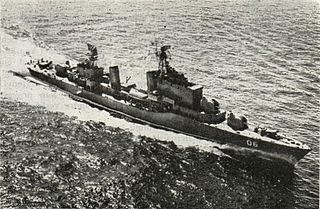
ARC 7 de Agosto (D-06) was a Swedish-built destroyer of the Colombian Navy. The ship, laid down in November 1955 as 13 de Junio, was built by the firm of Gotaverken in Gothenburg to the same design as the Royal Swedish Navy's Halland class of destroyers, with the exception that they had a third 120 mm turret in place of the 57 mm AA turret. The ship was launched on 19 June 1956 and completed on 31 October 1958. After a career that spanned almost 30 years, the ship was scrapped in 1984.

Bofors 120 mm Naval Automatic Gun L/50, also known as Bofors 120 mm gun model 1950 and the like, was a Swedish twin-barreled 120 mm (4.7 in) caliber fully automatic dual purpose naval gun turret system designed by Bofors from the end of the 1940s to the early 1950s to meet a request from the Dutch Navy. Besides the Dutch Navy, the weapon was also adopted by the Swedish and the Colombian Navy.
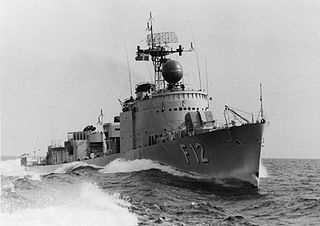
HSwMS Sundsvall (J12) was a Swedish destroyer, later rebuilt as a frigate, in the four-ship Visby class. The ship was named after the Swedish coastal city of Sundsvall. Sundsvall was laid down in 1942 during the Second World War, and was commissioned on 17 September 1943. She survived the war, and was modified and redesigned as a frigate in 1965. She was kept in service by the Swedish Navy until 1982, and was then used for testing of the Navy's RBS-15 anti-ship missile. The ship was later sold to Spain for scrapping.
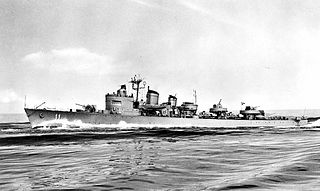
The Visby class was a Swedish World War II destroyer class. During the years 1942–1944 four ships, Visby, Sundsvall, Hälsingborg and Kalmar, were built and delivered to the Swedish navy. The ships were a part of Sweden's military buildup during the war. Under this period the ships were used as neutral guards and escort ships. In 1965 the ships were modified and rebuilt as frigates. Two of the ships were decommissioned in 1978 and the last two followed in 1982.

Maritiman is a floating maritime museum on the Göta Älv, in Gothenburg, Sweden. The museum's collection comprises 19 vessels, the oldest being HSwMS Sölve from 1875.

HSwMS Mode was a coastal destroyer of the Royal Swedish Navy, built by Götaverken and launched on 11 April 1942 as the lead of the four ship Mode class. Developed from an Italian design, the ship was capable of a wide range of roles, with depth charges to defeat submarines, torpedo tubes to attack ships and anti-aircraft guns for aerial defence, as well as mine laying capability. After serving during World War II, the ship was updated with greater anti-submarine capability and reclassified a frigate in 1953. Decommissioned on 1 July 1970, Mode subsequently operated in a training role until being scrapped in 1978.

HSwMS Mjölner was a coastal destroyer of the Royal Swedish Navy, built by Eriksbergs Mekaniska Verkstad and launched on 9 April 1942 as the last of the four ship Mode class. After serving during World War II, the ship was updated and reclassified a frigate in 1953. Decommissioned in 1966, Mjölner was sold for scrap in 1969.

HSwMS Nordenskjöld (12) was a destroyer in the Swedish Navy. Together with the sister ship HSwMS Ehrensköld, she constituted the Ehrensköld class, which, with its size and speed, was a major step in the Swedish destroyer fleet. The ship was launched on 19 June 1926. During the World War II, she participated in the neutrality watch and escorted merchant ships along the Swedish east coast. Especially the ore traffic from Luleå to Germany had to be protected. In the context of the neutrality watch, she therefore participated in the pursuit of Soviet submarines who broke out of the Gulf of Finland in search of merchant ships. Initially, Nordenskjöld had pennant number 12, which was later switched to 2. In 1951–1952, the ship was converted to frigate and then received the pennant number 72. She was decommissioned in 1963 and was sold for scrap the following year.
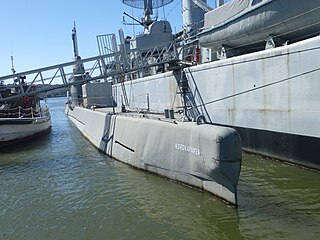
HSwMS Nordkaparen (Nor), was the fifth boat of the Draken-class submarine of the Swedish Navy.

HSwMS Halland (J18) was the lead ship of the Halland-class destroyer. She and HSwMS Småland were the only ones built of their class. Two more ships were ordered but they were never completed.

ARC 20 de Julio (D-05) is one of the two Colombian Halland-class destroyer. She and ARC 7 de Agosto were the only ones built of their class. Two more ships were ordered but they were never completed. She had the previous name of Veinte de Julio prior to renaming.

HMS Östergötland(J20) was the lead ship of the Östergötland-class destroyer.

HSwMS Södermanland(J21) was the second ship of the Östergötland-class destroyer.
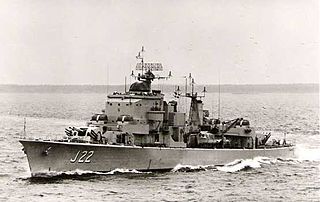
HSwMS Gästrikland(J22) was the third ship of the Östergötland-class destroyer.
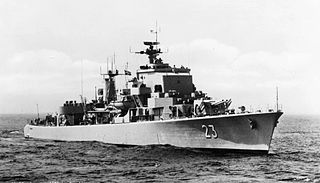
HSwMS Hälsingland(J23) was the fourth ship of the Östergötland-class destroyer.





















